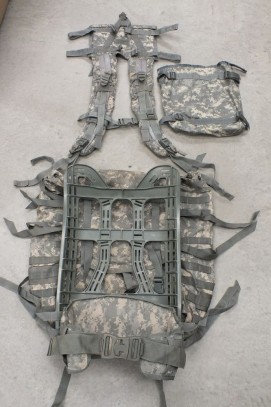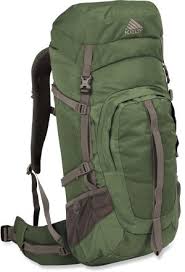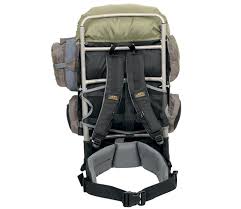Recently I listened to a discussion about which was best internal vs. external backpack frames. They never could agree on an answer. Since then I have been giving this some thought. Now over the years I have accumulated a number of backpacks having both internal and external frames. Having used both, I think that each one has pros and cons. However a lot will depend on what you plan on using the backpack for.
The pros of external backpack frames are. They position the weight high on your back, allowing good vertical load transfer to the hips and an upright walking posture. In hot weather, the frame keeps the pack away from your back, allowing lots of airflow between you and your pack. External backpack frames allow you to easily tie on extra gear. With the current trend being towards internal frame packs, external frame packs can often be found in garage sale for just a few dollars.

Most of the current US military packs have external frames. For years, I used the old Alice Pack and still have several. I currently like the MOLLE II USGI pack. The shoulder straps and kidney pad are adjustable up and down the lightweight plastic frame. This lets it work for different body heights. The shoulder straps are wide and comfortable. The kidney pad is wide and heavily padded. The waist strap is wide and has a quick release that makes it easy to get off. The plastic frame is quite strong and the only time I have seen one fail was when a friend tried to use one for a ladder. While I like this pack, I am currently passing it down to another member of my family. I am getting old and it is too large, I just need a smaller pack. If I have a large one, it will be filled up and get too heavy.
The downsides to external backpack frames are that many of them carry the weight high and away from your back, so you can lose stability, which can be a problem in rough country. Because of the protruding frame on many of the external frame backpacks, they will hang up on brush if you are boonie-crashing.

The pros of internal backpack frames are, they are streamlined and carry close to your body, this is an advantage when you are off the trail and bushwhacking. The pack is also more stable. In cold weather, having the pack close up against your body helps you to retain body heat. For airline and rail travel, internal frame packs are more compact and are hard to beat.
The cons are that many of the internal frame packs are top loading this means that you need to load the pack from the top. This is like filling a sack and can make it hard to find things in a hurry. Many of the commercial internal frame backpacks are designed to discourage you from strapping gear on the outside. This can make items like canteens, first aid kits and magazines hard to reach without stopping to take your pack off. Internal frame backpacks are not as good as externals in supporting heavy loads.
If you like to strap lots of items onto your pack, external frames are better. If you need to pack heavy supplies to a remote location, or pack out after a hunt, an external frame is the best choice. But if you are like me, old and limited on the amount of weight you can carry, take a look at some of the newer packs with internal frames, they can be very comfortable.
The bottom line is that they all have their place. Get out and experiment to find out which works best for your purposes.
Howard


Years ago I carried the military ALICE pack and thought it was wonderful, and for many people on a budget, it is still a good buy.
But for traveling through dense brush an internal frame pack is better. In fact, some units discarded the ALICE frame and used the foam sleeping pad inside against the back, to provide support and shape to the pack.
These days, like Howard, I am carrying lighter loads over shorter distances and my planning goal is a 10kg pack for trips up to 7 days. With today’s lightweight gear it can be done. I replaced my Medium ALICE pack with a 700 cu.-in. Coaxsher SR-1 Recon SAR pack with detachable 400 cu.-in. module. Its combined volume of 1100 cu.-in. or 18 Liters is more than adequate for my use. It is a professional grade rescue pack which will serve for a lifetime of use which costs no more than popular backpacking gear of questionable materials and construction, which failed during the first season of hard use.